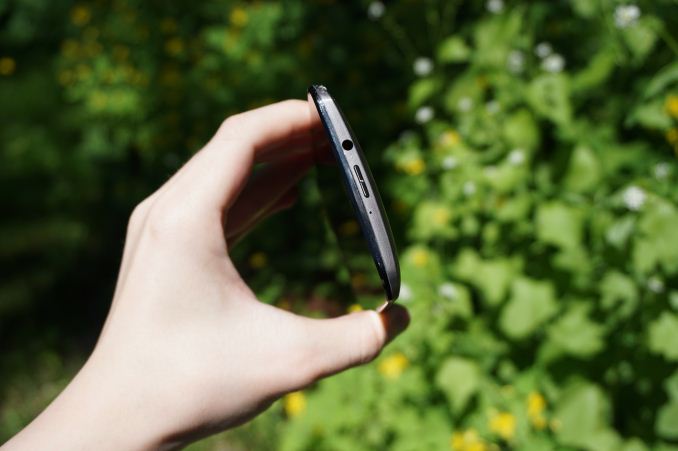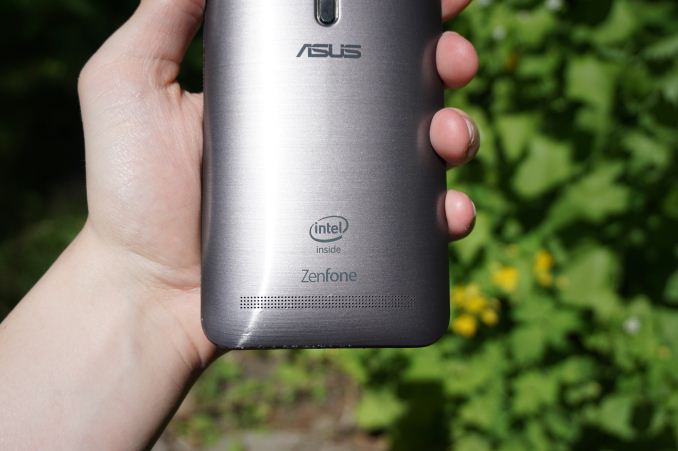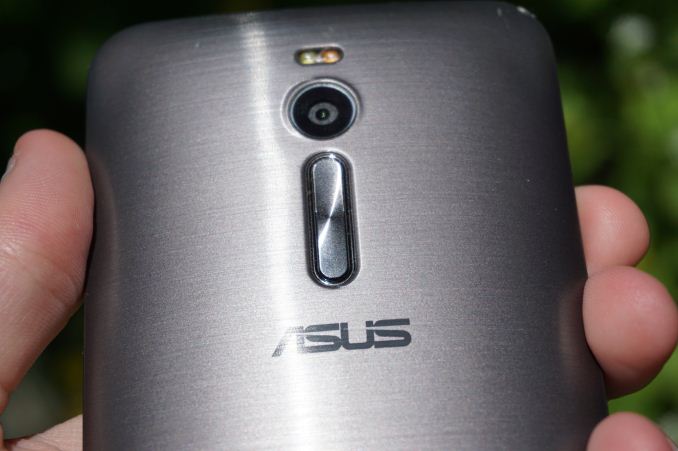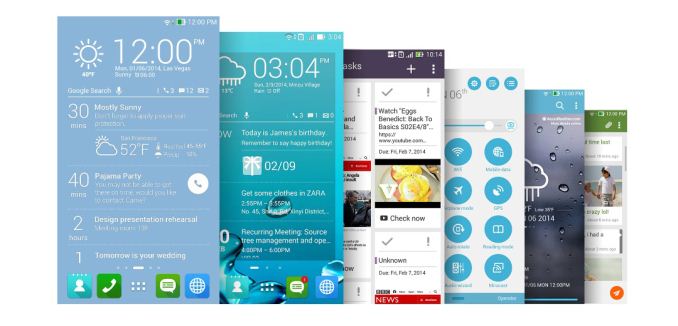The ASUS ZenFone 2 Review
by Brandon Chester on May 26, 2015 8:00 AM ESTFinal Words
Throughout the course of this review you may have noticed that I often compared the ZenFone 2 to high end smartphones like the Galaxy S6, the iPhone 5s and 6, the LG G3, etc. You may have felt that it was unfair to do so, as those smartphones will cost anywhere between two and four times as much as the ZenFone 2 depending on which model of each device you are comparing. In terms of price, the ZenFone 2 is competing with devices like the Moto G and the Lumia 735. You would be right to say that my comparisons have been very unfair. However, I think it says a great deal about the ZenFone 2's quality when the most relevant comparisons are often to devices that cost multiple times as much. It's a compliment toward ASUS and the work they've done to bring a high quality device to such a low price.
When discussing the ZenFone 2, I often find myself reminded of the Nexus 7, and more specifically the second generation model. It makes sense that I would be, as the Nexus 7 was also made by ASUS, and in many ways was similar to the ZenFone 2 in what it hoped to achieve. It had one of the best SoCs you could find in an Android device at the time, a class leading display, and great battery life. It put all of those things into a well built device that was only $219, well below the prices of the competition. The ZenFone 2 feels like ASUS bringing those same goals to the smartphone space. While the ZenFone 2's display isn't quite as good as the second generation Nexus 7 was, it's still very good relative to the price of the phone. That's a statement which can be applied to pretty much every other aspect of the ZenFone 2. In many respects it really does compete with phones that are priced significantly higher than it is.
I think the ZenFone 2 is a very well designed device given the price constraints that ASUS is working within. It has some very nice details like the brushed effect on the back cover, as well as the spun metal look on the volume rocker and on the bottom bezel beneath the display. When you hold the ZenFone 2 it's clearly not an aluminum device, and the finish that ASUS has applied to the plastic back cover doesn't try to trick you into thinking otherwise. But at a visual level it has a very convincing aluminum appearance to it, and I'm surprised that ASUS was able to replicate the reflections that brushed aluminum creates with a plastic back cover. The top mounted power button can definitely be a bit frustrating to use, but it's not the end of the world. The inclusion of double tap to wake on the display also reduces the need to use the power button.
ASUS, with the help of Intel, is really pushing the limits of what a smartphone can be when it has to meet such a low price. The ZenFone 2 offers CPU performance that should probably be creating some concern at Qualcomm, Apple, and Samsung. It's very competitive with the silicon that we see in the most expensive flagship phones available, and both ASUS and Intel should be proud. The SoC's GPU performance competitive with the last generation of flagship devices. While that sounds like criticism, the ZenFone 2's GPU performance is actually well ahead of the other devices that compete with it on price. Intel also handles the throttling of their SoC very gracefully, with GPU performance dropping to a point where it can be maintained for long periods of time rather than repeatedly rising and dropping due to the governor always targeting maximum performance.
While the ZenFone 2 has many positive aspects, it's not flawless by any means. The camera performance is very disappointing. I had really hoped that I would have overwhelming praise for the ZenFone 2's camera, as it's a feature that is so often poorly executed, particularly on inexpensive smartphones. Unfortunately, ASUS still has some things to learn when it comes to camera processing, and whatever processing is being done at the ISP level for videos is really not sufficient. I'm hopeful that the issues with JPEG processing can be addressed in future software updates. The camera is clearly capable of taking some good photos, and if ASUS can find somewhere in the middle of their current camera settings and the Optimization off setting then they'll have addressed one of the few major flaws with their device.
The other big flaw is that battery life is certainly not as good as you would expect from a device with a battery of this size. It's surprising to see such a huge gap in battery life between the ZenFone 2 and the OnePlus One which has the same display size and resolution, and nearly the same battery capacity. The lack of PSR and the relatively inefficient display are the biggest cause of the battery drain on the ZenFone 2, and it was very disappointing to discover this during the course of my use and testing. The ZenFone 2 is agonizingly close to being perfect for its price, but the battery life and the camera performance really let it down.
The last major point of the phone to discuss would be the software. Both the current software and software updates are definitely things that needs to be considered when buying the ZenFone 2. Since ASUS is a relatively new Android phone vendor, it's hard to say whether or not users can expect timely Android updates, or whether they can expect updates at all. I won't pass any judgement in that regard, and owners of ASUS tablets could give some insight into the level of support ASUS provides for their Android devices after launch. More relevant to the experience that users will have right now right now is ZenUI, ASUS's skin for Android.
I've heard some scathing criticism of ASUS's ZenUI, but I actually felt like it brought some useful additions to Android and didn't impede performance. I think some of the genuine improvements that OEM interfaces and modifications bring to Android are often overlooked, like having a battery percentage in the status bar, or re-enabling silent mode in the early releases of Lollipop. ZenUI was also one of the smoothest interfaces I've ever used. It's hard to put it into words, but some of the launcher animations felt much less mechanical than they do on stock Android, and I rarely noticed any slowdown or jank.
While I think ZenUI definitely gets a lot of things right, I don't hold the overall software experience on the ZenFone 2 in such a high regard. Much of this has to do with preinstalled bloatware. ASUS is best known as a PC vendor, and the ZenFone has enough useless preinstalled software to rival the amount you get on a Windows computer. It ranges from useless apps like the Mirror app which just turns on the front facing camera, to what is quite frankly shovelware like "50+ Games!" and "Clean Master". I feel somewhat bad though, because the deals to include these apps might be one of the only ways that the phone makes ASUS any money.
I suppose that the final question boils down to whether or not the ZenFone 2 is worth buying. Despite its flaws, I would say that the answer is yes for both models. However, I think it's important to make the right decision about which model you purchase, as the higher end SKU costs 50% more than the entry level one. I don't think the faster max CPU clock on the high end model is really worth considering, and while the 4GB of RAM is something that you can brag about, Android functions perfectly well with 2GB or 3GB of RAM.
I think the most important considerations are actually the BoostMaster charger, and the amount of internal NAND. If you like using a high brightness, or if you frequently use your phone in high display APL scenarios such as web browsing, you're going get less than stellar battery life. Having the ability to charge the phone quickly helps to offset the battery frustration. Buying a fast charger like the Motorola Turbo Charger separately is going to set you back around $35, and at that point it may be worth it to just invest in the $299 model. If you need more than 16GB of storage then the $299 model is definitely the one to buy. If you're okay with slower charging or have a faster charger already, and 16GB is enough for you, then I think the $199 model is a great purchase.
To wrap things up, I'll say that I think the ZenFone 2 is now the device to beat at both of its price points. I think most users who are interested in a phone like the ZenFone 2 will opt for the $199 model, but the $299 model also presents a great value for users who want the higher end specs and the incredibly fast charging. I don't really know where the competition in this part of the market will go, as it's hard to imagine that ASUS or any other vendor could possibly provide even better specs or more features at this price point. ASUS definitely has a great product on their hands, and now that it's available worldwide, users will soon be able to experience it for themselves.















147 Comments
View All Comments
re2onance - Friday, May 29, 2015 - link
nm, apparently that isn't correctmeacupla - Tuesday, May 26, 2015 - link
ok, done deal for a protective case for this thing then.blzd - Thursday, May 28, 2015 - link
That's one of the issues with larger phones such as this.jjj - Tuesday, May 26, 2015 - link
Actually in many markets the top Zenfone does compete with the G3 , S5 and the likes on price. Asus isn't quite hitting the 300$ + tax price everywhere and older flagships do get cheaper. The currency drops in some markets are not helping them either. The 200$ model is better value but it competes with A53 based devices that can be plenty cheaper with similar specs In China the TLC Meme da 3S ( 5inch 1080p , SD615 , 2GB RAM , 16GB NAND , 13MP and 8MP cams ,3050mAh ,139.6x69.6x8.9mm ,130g) just launched at 799CNY and that's 129$. Differences aside, they do have to compete with such devices. For the 300$ device you also got the soon to arrive SoCs, spending 300$ on this now might feel like a mistake in a few months.Wish you had the 1.8GHz 4GB RAM and 2GB RAM versions (they do have a lower clocked 4GB version) to compare battery life. In browsing the 4GB of RAM might be what kills it so fast.
Always wanted to ask about the LTE battery test , how much of the time time is idle or each of the LTE power states. Or maybe even better, how much data is used per minute or hour or w/e. Americans can afford to use a few GB per month but most of the world uses 10 times less or worse. In any case, the daily average usage is from almost 0 to bellow 200MB so LTE is most of the time idle if not disabled. Knowing how much data you use in testing battery life would help understand the relevance of the test and maybe help you better calibrate it in the future. So any chance you can provide some (rough) estimate on data usage when doing that test? Right now we have no idea if it's 60MB per hour or 10 times less and that's a huge range.
menting - Tuesday, May 26, 2015 - link
Frankly, I don't think the difference in 4GB RAM and 2GB RAM should make that much of a difference. A difference of doubling the refresh rate in the DRAM, as well as the difference in idle power should be peanuts compared to to what the other components are pulling.Glock24 - Tuesday, May 26, 2015 - link
I'm also interested in knowing if there's any difference in battery life between the 1.8GHz 2GB and 2.33GHz 4GB version.Some people in forums are saying the 4GB version drains the battery faster, some say the high battery drain was due to some bug in Lollipop. Maybe this was already addressed in a system update? All those comments about poor battery life of the 4GB phone come from people using the TW or India version with factory software version (which I assume is older than that on the US version). But still, would be interesting to know for sure if the 2GB version has better battery life.
I've read some people complain about the phone overheating, but there's no mention about temperatures in the review. Does it get hot during heavy use? Does it become so hot it's not comfortable to hold?
In the review Brandon talks about preinstalled bloatware, but does not mention about any useful bundled software. For example, I've read in other reviews about a bundled app that gives the user granular control over which applications run in the background and which ones are allowed to autostart, without the need for the phone to be rooted.
Also Asus gives you 5GB storage in Asus's own service with each device. How well or bad does the Asus Cloud app work? Does it make automatic backups? Is it easy to setup or use?
Chinaphonearena - Tuesday, May 26, 2015 - link
An outstanding review, man. Truly. I hope you don't mind me plugging my own of the 2gb/16gb/1080p model. It's not nearly as technical or thorough as this, but some may get something out of it.http://www.gizbeat.com/7449/asus-zenfone-2-full-re...
Also the tear down of the phone from a Taiwanese user, which shows some of the components Asus is using.
http://www.gizbeat.com/7622/take-a-look-inside-the...
ketacdx - Tuesday, May 26, 2015 - link
I have a TW 4GB model and its been getting 2 software updates a month fixing little things here and there on top of the ZenUI updates. I have not had any overheating or even it getting warm. My Nexus 5 from before this got way more hot. There is an Auto-start manager which is kind of neat but 80% of the preinstalled stuff is useless. Luckily most of it can be uninstalled and not just disabled which is cool. I don't know about the US model but the TW model gives me 100 GB's of free Google Drive storage for 2 years. I am in Canada and it enabled fine. I have never used to Asus cloud so I don't know how much they provide.Manch - Tuesday, May 26, 2015 - link
I'd like to see Windows Mobile loaded onto this and the benchmarks run again. Is that possible? MS said they would release a ROM that could be installed over android.Gich - Tuesday, May 26, 2015 - link
I think they made only a ROM for Xiaomi Mi4...